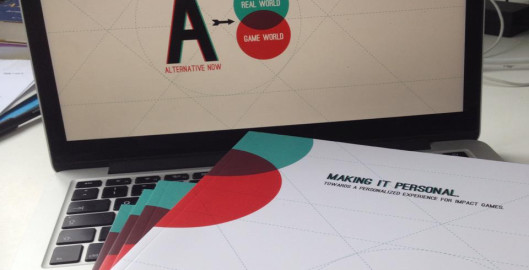Blog
17
Oct
2013
In Blog
Games – Personalization – Impact
On 17, Oct 2013 | In Blog
I decided to post the introduction chapter to my M.A. thesis about games, personalization and impact here on my blog. The thesis started out with the ultra short working title “Enhancing The Player’s Identification With The Subject Of A Story-Driven Social Impact Game By Implementing The Individual’s Social Network-Data Into The Game-Narrative” – I reconsidered it. You´re welcome!
Making it Personal – Towards a personalized experience for impact games.
INTRODUCTION
“If you want to send a message, call Western Union.“
Samuel Goldwyn, MGM, 1942.
“If you want to criticize a religion, write a book. If you want to describe sex, write a book or a song …“
Apple Developer´s Guideline to the App Store, 2013.
Back in the early 1940s, in the golden age of Hollywood Cinema, American film studio moguls “tended to view entertainment and social comment as incompatible“ (Schatz 1994, 263). Film history has proven otherwise and has brought forth substantial counter-evidence to make moving pictures, that means documentary films, television reports, and event-based online videos on Youtube the leitmedium for raising awareness and initiating social transformation processes (cf. Fig. 1).
Throughout history one finds many examples of activists and artists employing the arts as a medium to leverage change in their societies, with variating range and results (cf. Fig 2).
Ray Bradbury´s ingenius 1953 dystopian novel Fahrenheit 451 (Bradbury 1953) for example, addresses the power of mass media being an influential tool on society. The book features an American society that has exchanged a culture of diversity and freedom of thought for a conformist and heteronomous life. In the novel this passive attitude is represented by the abandonment of books in exchange for the indoctrinating, manipulative and numbing national television. Being written in the McCarthy era as a comment on the threat of state regulated censorship, Fahrenheit 451 perfectly illustrates the opportunity and risk of the media and has itself become a highly influential and critically acclaimed piece of art.
A positive example for the extensive impact of film is Morgan Spurlock´s Super Size Me (Spulock 2004). The documentary about McDonalds initiated a corporate policy shift and kicked a nation-wide raise of awareness about healthy nutrition and subsequently a positive change of customer behavior in the USA (NYC Government 2013). Due to the simple message and its highly entertaining nature the movie successfully made its way all around the world and can be thus considered one of the most influential documentaries of all time.
In his 1964 essay Media Hot And Cold, media theorist Marshall McLuhan introduces the concept of “hot“ and “cold“ as metaphors for low and high user participation towards the interpretation and comprehension of media contents. “Any hot medium allows of less participation than a cool one, as a lecture makes for less participation than a seminar, and a book for less than a dialogue“ (McLuhan 1994, 25). According to McLuhan this quality is based on each medium´s ability to either communicate a message directly or abstractly.
I hypothesize, that in the age of the internet with its associated paradigm shift from one-way to feedback-based communication between author and audience, we are facing today a promising constellation of media-historical factors that allow the conversion of socially engaged art into social practice and empowerment of the masses. Recalling McLuhan´s concept and adapting it to today´s fragmented, networked and interactive culture, the overall “cooling of media“ (Navas 2013) – an increase of the consumer participation, could be seen as the golden opportunity of transforming audiences into activists.
GAMES FOR CHANGE
From an economic perspective, fictional digital games have successfully outperformed their linear counterparts in film
(Combs 2011) but still, in the public eye, games are only half-way through the process of becoming a serious legitimate and socially acceptable medium. At the same time (or maybe for exactly this reason), today´s gaming industry is on the verge of an indispensable aesthetic evolutionary step. In my opinion, the major opportunity for games to truly become the leitmedium of our time, lies in the unexplored potential to express meaningful messages from the real-world and communicate them through their unique mix of story and gameplay.
BOTTOM UP
While most big players of the industry are keeping ancient game concepts on life support by injecting visually intriguing hyperreality, independent developers and academic research & development teams have been pushing the boundaries of game design for some time – both in the fictional and documentary sectors.
With the release of her critically acclaimed game “Darfur is Dying“ in April 2006, game designer Suzanna Ruiz, at the time a graduate student at the University of Southern California‘s Interactive Media Division, delivered the proof of concept that digital games have the potential to communicate real-world is-sues to the player. Within six months after its launch more than 800,000 people had played “Darfur is Dying“. Ever since, the game “has been the focus of debate on its nature and impact“ (Wikipedia 2013). Looking at these numbers, “Darfur is Dying“ certainly raised awareness for the Darfur-crisis amongst players, but was there any active short term or long term impact for the citizens of Darfur who were featured through the game?
In her 2010 TED Talk, Games Evangelist Jane McGonigal envisions a future in which the mindset when being in a state of play can actually be used to change reality for the better:
When we‘re in game worlds I believe that many of us become the best version of ourselves, the most likely to help at a moment‘s notice, the most likely to stick with a problem as long at it takes, to get up after failure and try again. […] What about games makes it impossible to feel that we can‘t achieve everything?
Both Mc Gonigal´s TED talk and her popular book Reality is Broken (McGonigal 2011) contributed to a shift in the public discussion about play as a means of engagement instead of escapism. Following her argument, gamers (and hence, games) could become the driving force of social change in the near future by overcoming the gap between virtual and physical reality through playing games that address real-world issues.
The unique quality of well designed digital games is their ability to engage and immerse the player by making him/her the driving force of an experience that cannot unfold and therefore does not exist without them. “To activate the game-narrative, players have to fullfill their duty to interact – without interaction the game stops“, states Martin Gantefoehr at the 2010 Clash of Realities Computer Game Conference (cf. Tillmanns 2010). According to Ganteföhr, film-audiences could easily switch between identification and dissociation (…) without jumping off. In games, dissociation would lead to the denouncement of the interaction-contract. For so-called serious games, that means games that are beyond entertainment, this “interaction contract“ is the major challenge and inate breaking point.
The popular term “serious games“ illustrates in itself, that the failure of this game genre is inevitable. While it is the nature of games to be “a problem-solving activity, approached with a playful attitude“(Schell 2008, 37), the serious topic and theme of the game-story combined with the way it is presented though gameplay o˜ en dramatically interferes with the inherent need of a game to be captivating and fun. A standardized point-and-click adventure framework that confronts players with an over-whelming amount of text info and poorly animated characters is therefore of no help when aiming to trigger emotions and communicate a meaningful and lasting message through digital games. Since the majority of serious games rely on extrinsic rewarding systems, the player´s motivation to play is mainly addressed by the run for achievements, ranking and badges.
To my mind designing for social and cultural impact, empowerment and inclusion eventually requires an immersive and intrinsically rewarding gaming experience that on the one hand creates an emotional bond between the player, the game world and the in-game characters and on the other hand transforms this bond into an ongoing identification with the subject of the game.
Part A of this paper is therefore dedicated to evaluate game de-sign elements that contribute to immersion and identification. Furthermore the potential of a personalized game narrative that seemlessly integrates the player´s personal reality into the fictional context of the game will be introduced. Part B will then present a micro study that analyzes the acceptance and attachment of a player to a certain topic after having played a personalized prototype game. Finally the thematic field of application for personalization in games will be discussed.
# # # End of excerpt. See the table of content below for an overview of the thesis. # # #
CONTENT
Acknowledgements 6
Introduction 10
PART A:
1. The Many Faces of (Social) Impact Games 18
1.1 The Cat and the Coup 21
1.2 Half the Sky 22
1.3 September 12th 23
2. From game-based learning to games for change 25
2.1 The Emotional Bond 26
3. Dimensions of the Magic Circle 30
3.1 The Alternative Now 32
4. Persuasive Design 34
4.1 Technology 35
4.2 Audiovisual Challenges 36
4.3 The truth about reality 37
5. Immersion and Identifcation 39
5.1 The Means of Interaction 39
5.2 The Phylogeny of Narrative 40
5.3 Role playing 42
6. The Identity and the Self 44
6.1 The Identity and the Self 44
6.2 Online Biographies 45
7. Customization, Personalization, Representation 47
7.1 Big Data 48
7.1.1 Personalized Media and Viral Campaigns 51
7.2 I share therefore I am 52
7.2.1 The Trouble with the Double Narrative 53
7.3 Introduction to the Facebook API 54
7.3.1 ID Slots 55
7.3.2 API Layering 58
7.4 Advanced Personalization Through Data Design 59
7.5 Levels of Personalization 62
8. Conclusions 64
8.1 What The Audience Wants 64
8.2 Business Model 65
8.3 Field of application 66
PART B:
1. Methodology 70
1.1 Game Prototype: The Mysterious Bag | Script 72
2. Study Design 76
2.1 Study Setup 76
3. Evaluation 78
PART C:
Documentation 80
I Microstudy 82
I.I Questionnaire 82
I.II Simple Statistic Evaluation 88
II. Prototype-Mockup 92
III. Interview questions (German) 92
Bibliography 94
Picture Credits 100
Declaration of Authorship 103



